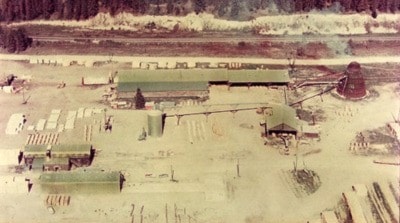Last months’s official reopening of Canfor’s Vavenby sawmill was just the latest chapter in the long history of the forest industry in the North Thompson Valley’s Vavenby-Clearwater area.
The earliest sawmill in the Vavenby area likely was a waterwheel-powered mill located next to Lost Creek, north of town.
According to an item about Vavenby by Joan Unterschultz in the local history book, Upper North Thompson Reflections, the mill was set up in 1912 by Knute Skahl and Martin Thompson to make ties and planks for the CNR.
The settlement at Lost Creek was mainly made up of Scandinavians.
Apparently the remains of the mill can still be seen.
Lumber from Ernie Dee’s mill was used to build a new school for Vavenby in 1927. The building cost $1,200 and was on the south side of the river just upstream from the ferry crossing.
Dee had first come to Vavenby in 1910 when he helped his father deliver supplies to Moilliet’s store. After a period of driving teams to Kamloops, he bought his first place on Lost Creek Road in 1925 and decided to run his own sawmill, making ties for the railroad.
He took seven days to drive a tractor from Kamloops to Vavenby. It was the first tractor used in logging that he knew of. It only traveled at 2 1/2 miles an hour but had lots of power - he could pull as much as 1,700 feet of logs with it.
A pole yard was developed in Vavenby in 1930, with a log boom in the river. Apparently the yard lasted a long time, with poles being sent to Siglet Pole Co. for many years.
Much of the sawmilling in the early days was done in the bush at places such as Whisky Camp, which was located in the mountains south of Vavenby, according to longtime local logger Ernie Graffunder.
The logs would be tail-dragged from the forest by specially equipped trucks into the camp. The wood was sawn into rough cut boards and trucked into Vavenby, where it was planed and sorted.
Birch Island Lumber Company owned Whisky Camp. The company belonged to a man named Boltby from Vancouver. Graffunder said he met him a few times when he traveled up to Vavenby by train.
The operation that is now Canfor-Vavenby got its start in 1941 when Frank and Paul Capostinsky traveled from Alberta to look for logging and sawmilling opportunities in the North Thompson Valley.
Working under contract to Swanson Lumber Company of Edmonton, they set up a business under the Capostinsky name.
Businesses involved in the formation of what would become Clearwater Timber Products (CTP) included Archibald Sawmills Ltd., Birch Island Lumber Company Ltd., and Thompson River Logging Company.
According to an article about the BC Forest Service by Mel Monteith in North Thompson Reflections, the provincial government offered a special form of tenure in 1968, the Timber Sale License. The major forest companies in the North Thompson Valley obtained their licenses the following year and a boom resulted. In 1967 logging and milling employed 534 in the Birch Island and Blue River Districts. In 1972 that figure was 976.
In 1987 Slocan Forest Products Ltd. (later Slocan Group) bought CTP. The Camp 2 sawmill and planer mill on the Flats in Clearwater were shut down and modern machinery installed in Vavenby.
More modernization was done at Vavenby in 1995.
In 2004 Slocan, then Canada’s fifth largest lumber producer, merged with Canfor, the number one producer.
Five years later, in 2009, Canfor closed its Vavenby operation due to market conditions.
In February of this year the company announced that it planned to reopen the mill this fall after making extensive capital improvements.
According to Canfor, 96 jobs will be created at the mill by the end of September, plus another 30 in logging and tucking.
